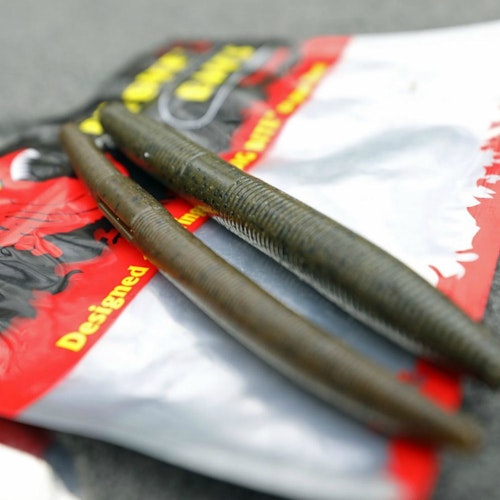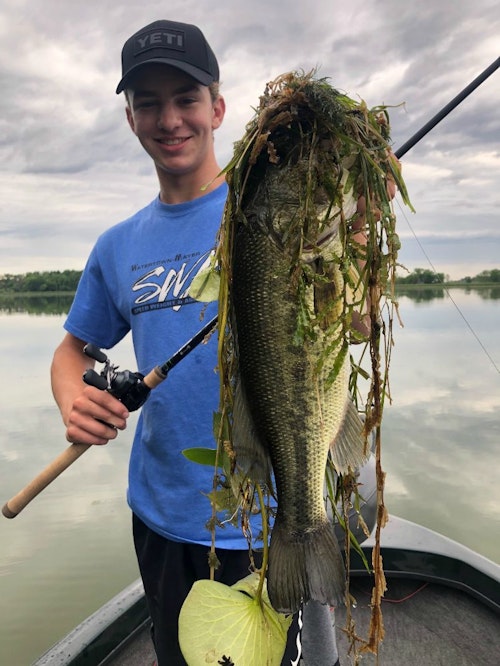
The author’s son (left) with a summertime Minnesota largemouth caught on a Jackall Gavacho Frog. When bass miss his hollow-bodied frog, however, he quickly tosses back to the fish with a Texas-rigged stickworm, like this Fat Stick (right) from Big Bite Baits.
You know the drill: Cast a hollow-bodied frog far over emergent vegetation, retrieve it with a methodical twitch, twitch, twitch cadence and then at some point an aggressive largemouth explodes on the lure. You wait a split-second, wind up the slack line and then hammer home the hooks, but it’s a swing-and-a-miss. Damn!
At this point, 99% of bass anglers will quickly inspect the frog, fix it if needed and remove weeds, and then fire it back to the dinner-plate-sized crater in the slop. And the bass rarely eats again.
Time for a better game plan, okay?
Stickworm to the Rescue
The next time you hit the water for an evening of froggin’, rig up a second baitcaster with a 5- or 6-inch Senko from Gary Yamamoto Custom Baits or similar thick-bodied soft-plastic stickworm. My personal favorite is the 5-inch Fat Stick from Big Bite Baits.
Because a stickworm is heavy, you shouldn’t need a sinker, but if it’s windy, go ahead and add a small split-shot or lightweight bullet sinker. Instead of presenting the stickworm wacky-style, it’s best in heavy cover to Texas-rig it with the hook pushed through the far side of the worm with the hook point lightly buried back into the worm (top photo, right).
Practice casting it a time or two to get a feel for the system, and also pay attention to its sink rate, which should be slow.
As you make your way along the bank with the frog, have the stickworm rod ready to roll at your feet. When you fail to hook a bass that blows up on your frog, immediately stop the boat, drop the frog rod, and cast back to the fish with the stickworm. If you can’t land the lure in the hole created by the bass explosion, then cast just beyond it and quickly bring the worm into the hole. Then let the stickworm sink. Pull a bit of line off the reel to encourage the worm to fall a foot or two below the surface. If the bass doesn’t grab the stickworm immediately, then shake it in place. Be patient because it might take the bass 30 seconds to set up in the area again and find the stickworm.
Of course, when you see a boil and feel weight, or see your line go tight, set the hook hard.
Depending on your rod/reel/line combo, you might not be able to horse the bass out of the heavy cover as you would with your froggin’ setup. No worries. Simply get back on the trolling motor and move to the fish, keeping the line tight as you close the distance.

While most bass fishermen choose braid whenever fishing near heavy cover, I often go with 17-pound mono for my follow-up stickworm presentation, regardless of weed thickness. With a medium-heavy rod and topnotch baitcasting reel spooled with 17-pound mono, I can cast a stickworm accurately and far, and it falls beautifully into the weed pockets. If the follow-up fish is small, say 14 inches or less, I can bring it through the vegetation to me with this gear. If it’s a bigger bass, however, then I let it swim around in the weeds (tight line, of course) until my trolling motor enables me to show up on the scene to land it.






